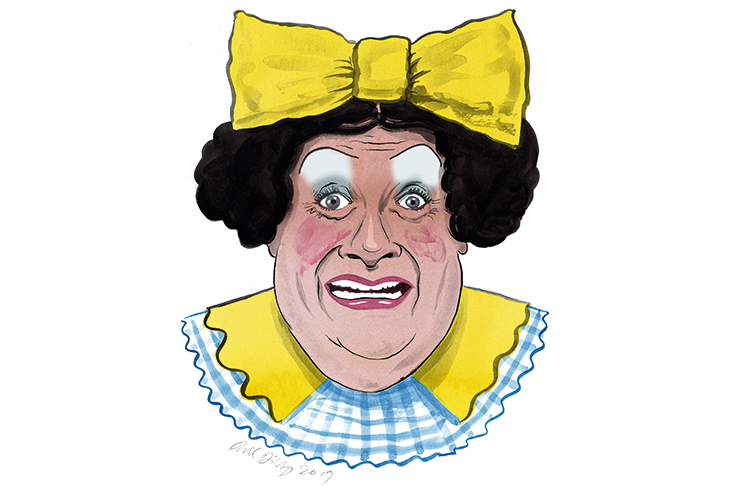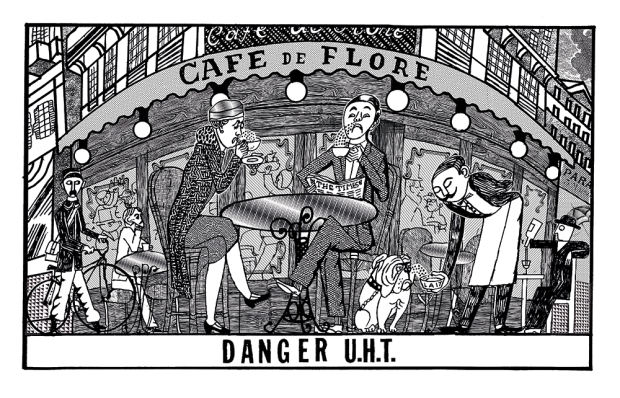Christopher Biggins has managed to bag some of the nation’s favourite TV characters over the years: Lukewarm in Porridge and Nero in I, Claudius, to name but two. Yet there’s a good chance he wouldn’t have had a career at all if it hadn’t been for his Aunty Vi. She was ‘the most terrible snob’, he tells me. The family accent (a mishmash of northern and broad Wiltshire) troubled her, so she sent the young Biggins off for elocution lessons. His teacher was also into theatre, and saw he had potential. Her encouragement and the new accent saw him start in rep on £2 a week. He left school at 16, bitten by the bug. Fifty-five years later he’s still busy, still bitten.
It’s that time of year when Biggins comes to the fore as one of the grand dames of British pantomime. He was just 26 when he got his first role as Mother Goose at Darlington’s Civic Theatre. At the time he felt insulted — every other pantomime dame seemed ancient. But the producer saw something in him. What the young Biggins saw was big money (£1,000 a week in 1974), but as time has gone on he’s come to love pantomime. Now, he’s its loudest cheerleader.
Why does he think it’s such a national obsession? ‘It’s pure family entertainment. I have looked out into the front row and seen a woman breastfeeding her baby, next to grandmother. In the old days actors used to look down their noses at pantomime. It was “Oh God, not pantomime!” But as an actor it is fantastic. Twelve shows a week, the audience laughing. It lifts you to another planet.’
He’s had some of his best times in panto. ‘I was in Brighton co-starring with Irene Handl. She was mad as a hatter. She had a habit of barging on stage carrying her dog when it wasn’t her scene. She’d hand me the dog and then walk off. We called these her mirage moments. Now you see her, now you don’t.’
I ask Biggins what his favourite dame role is. It’s Mother Goose, the character that was around in the early days of panto in the 18th century — an imported French children’s story. ‘Mother Goose is the Hamlet of all dames. It is all about her and her vanity. She is a tragic heroine. It’s a great shame that there are very few Mother Goose pantos put on these days. Directors say that it isn’t popular enough, but I love the character. I once played her in Swansea when she died at the end of the first act and was carried off to heaven by a 40ft-wingspan goose to the tune of “We’ll Keep a Welcome in the Hillside”. She was resurrected in the second act. There wasn’t a dry eye in the house.’
If Biggins sounds evangelistic about panto, that’s because he is. He’s even persuaded his friend Joan Collins to have a crack at it. ‘I think her ears pricked up when I told her how much people could earn. Joan was good at it, though. You either are panto, or you aren’t.’
He believes that panto is an art form, and who could challenge that? It is, perhaps, best described as a kind of folk art as it brings in audiences who may never have been to the theatre before. It also accounts for a disproportionately large slab of most theatres’ earnings. It is certainly hard work for the actors and takes a lot of energy, what with all those shows every week, numerous costume changes and roles that are often very physically demanding.
‘The hardest show is Boxing Day. People have eaten too much and they kind of slump into their seats demanding to be entertained. It is daunting.’
It surprises me to discover that Biggins considers his career highlight to be winning I’m a Celebrity… Get Me Out of Here more than a decade ago. People still congratulate him on his victory, which he describes as ‘an honour’. Although he also still has nightmares about eating kangaroo testicles.
‘It meant so much that people voted for me. To find you have the public behind you is really something and really continues to be something I am so happy about.’
I ask him if the resurgence of interest in drag has made the pantomime dame more popular. But for him, the skirts and the female clothes are props there to help get a laugh, that’s all. Being the dame is about acting. What the dame does isn’t drag, it’s a kind of pure comedy. He tells me that he doesn’t even have his costumes in his dressing room with him. He just has a comfortable chair, a foldaway bed for a mid-show snooze, a TV and a small stove for his M&S lunches. Who needs the glamour of a few frocks?
‘Interestingly, drag queens don’t make good pantomime dames. They are much better at being the Ugly Sisters — they have a wonderful danger about them. I’m too pretty, of course, to play an Ugly Sister.’
As well as playing the dame, Biggins has made a career out of playing vicars, although most of them are nasty ones —including a very juicy sex-crazed cleric in Poldark. I ask him if he has any tips for me — a real vicar. ‘I love vicars. I wanted to be a vicar when I was younger. I don’t think that I can really give you any tips. The best vicars bring people joy and hope and that’s something quite wonderful.’
Christmas is a special time for vicars and pantomime dames. We have quite a lot in common — we wear dresses, we are very busy during the period and we are part of a landscape that brings a little hope and joy. That can’t be bad, can it?
Got something to add? Join the discussion and comment below.
Get 10 issues for just $10
Subscribe to The Spectator Australia today for the next 10 magazine issues, plus full online access, for just $10.
You might disagree with half of it, but you’ll enjoy reading all of it. Try your first month for free, then just $2 a week for the remainder of your first year.














Comments
Don't miss out
Join the conversation with other Spectator Australia readers. Subscribe to leave a comment.
SUBSCRIBEAlready a subscriber? Log in